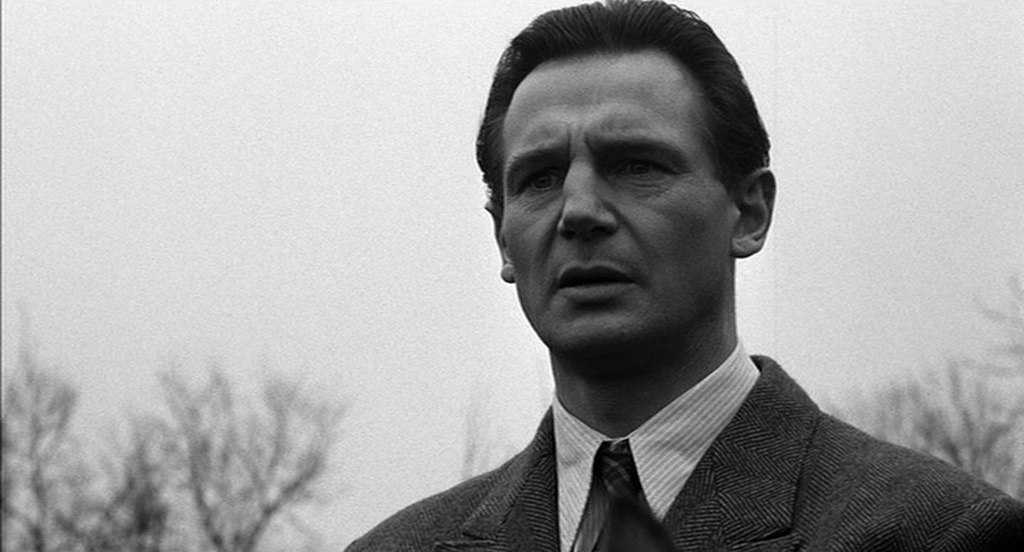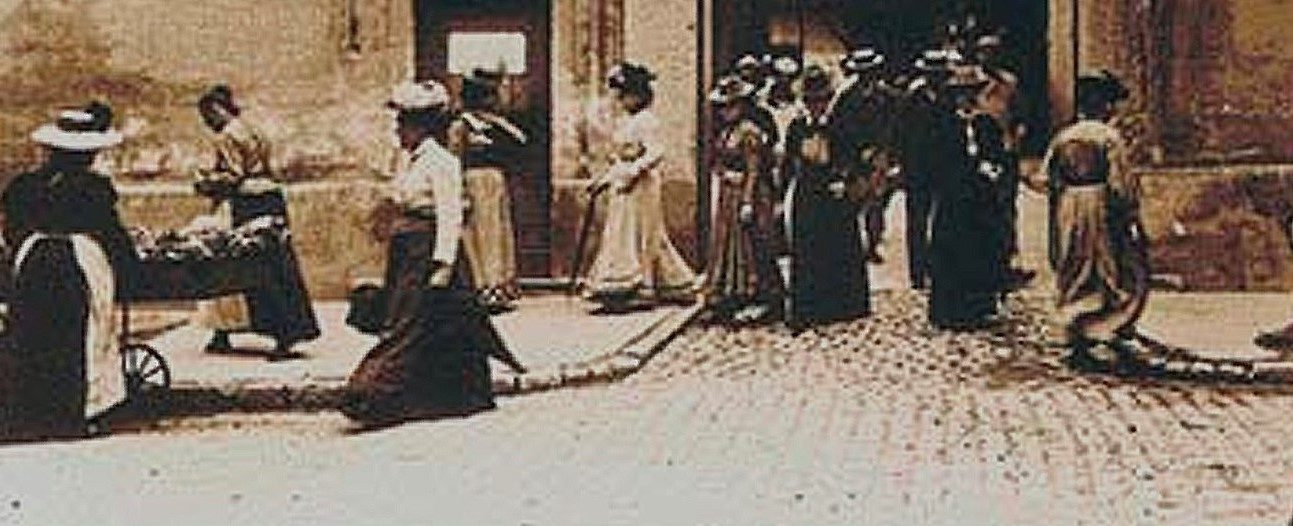United States, 1993
Directed by Steven Spielberg
With Liam Neeson (Oskar Schindler), Ben Kingsley (Itzhak Stern), Ralph Fiennes (Amon Goeth)

The weirdest, most egregious, most hotly debated images in “Schindler’s List” are the still long shots and the more roving and medium ones focused on a walking little girl, who is anxiously wondering where to go and what to do amid the mayhem that the Nazi soldiers are wrecking as they hunt down and massacre the inhabitants living in Krakow’s Jewish ghetto in the winter of 1943, with the aim of destroying a community barely two years after they established it. It is not just that the desperate little girl is front and center: it is the surprising fact her coat appears red, a stunning, baffling touch of color in the black and white images, in the constantly and wonderful black and white cinematography crafted to underline the historical and tragic dimensions of the narrative.
This astonishing artistic choice cannot be fully understood if it is taken outside the dynamics of the montage of the whole sequence. It could have another thing, or simply nothing at all, but it is this little girl that, according to the cross-cutting editing, catches the attention of Oskar Schindler and makes his observation from a distant, elevated place, as he is riding a horse, an even more upsetting experience to him – once again the expression creeping in his face and even more his gaze speak volume, as it has been the case from his first appearance on the screen and would be till the last. The strong emotion he seems to feel would haunt him, and even more when the dead body of the little girl, with once again her coat colored red, is dug up to be burnt with countless others later, a horrific operation he has been invited to witness.
This red coat is like the candle’s flame of this feature’s establishing shot, the first images shot in color in the film, a sign whose observation leads to another dimension, tipping the audience from one world to another. At the beginning, the flame is a visual, elegant trick moving the audience from the present time of the shooting and the nice reality of a tranquil Jewish family performing religious rites in an ordinary background to the distant and dreadful past and the grim reality of Jews under threat as Poland is invaded by the Adolf Hitler-ruled Germany. Later, the red coat would be an equally vivid sign pointing to a conscience which wanted to be as practical, and cynical, as possible, to a conscience increasingly concerned with the need to rescue and to guide. The vision of the little girl, it is suggested, helps prodding Oskar Schindler into altering his views, that is, moving to higher moral grounds – better late than never. The vision of the candle’s flame had previously invited the audience to grasp the moral quagmire the lead character would be.
A first problem is that even when Oskar Schindler trots off his vantage point and exits the editing of the aforementioned sequence, the film keeps recording the plight of the little girl, still colored in red: even if the dialectics have stopped working the symbol is hammered home to remind the audience how dire her plight is. Then, on the longer term, if the change of heart of Oskar Schindler obviously drives the plot, standing as the momentous and positive change of his own narrative arc, it takes a truly slow time to have consequences, his story getting at times lost inside the wider picture of the Shoah the film is so keen to take, and does deliver. Above all, this change remains barely explained and is never fully articulated by the hero: the capitalist becomes a savior never voicing his feelings, reasons, or views and the film never tries hard to delve deep into his behaviors and reactions.
In short, the trouble is, however moving and genuine this change is, it remains framed within an effective, calibrated, superficial melodrama register strong on symbols that are easy to notice and to relate to but are nevertheless just the tested and tried tools of a wider and sleeker system. The right emotional and moral buttons are safely hit, the depiction of the appalling historical context sounds perfect, the images are neat and powerful, but the effort relies conspicuously on over-emphatic elements and situations as well as stark and basic contrasts. The Shoah is handled as a dramatic show aiming at praising an unexpected moral beacon emerging from a hopeless and devious world, and it comes as no surprise that the film reverts back to the present time and color stocks to display the lasting impact of Oskar Schindler – the six thousand Jews still alive today thanks to his effort, compared (clumsily) to the only four thousand living in 1993 in Poland.
Some may be rightly moved but the end product is just too obvious and calculated to please fully, even as it is arguably a remarkably effective and a thoroughly interesting film to watch, an entertainment sincerely and relentlessly tackling a genocide (and that is important, praiseworthy, legitimate too: to argue as some critics, intellectuals, artists even, did that is was a wholly futile and unacceptable endeavor is stupid; art can and even should try to deal with historical events and tragedies to grasp not just the chain of events but to reflect on the experience it was for many people, the challenge it was for our humanity). Yet greater complexity, more nuances, better insights would have make it far more compelling and unforgettable.
Actually, the film settles on a lead character that is far from pleasant, even if he is always eager to seduce. Oskar Schindler is shot from the start as the quintessential wheeler-dealer, flamboyant, cunning, cheeky, ready to splurge his money to ingratiate himself into the Nazi elite ruling Poland and a Jewish community under threat. He clearly voices his goal: to prove his relatives and others he can be a big industrialist and make a pile easily. He makes no secret he got in touch with Itzhak Stern because this Jew was the skilled accountant of the factory he wants to buy and can be his entry point into the Jewish community, making it easier to recruit and to rally support. The film shows with zest and a fair degree of bluntness how the pampered and suave philanderer is unashamedly corrupting officials and exploiting persecuted people.
The arrival of a new Nazi commander for the area, Amos Goeth, could have changed little – a cross-cutting montage in a quite didactic fashion shows them as like-minded rivals. But if Amos Goeth proves to be barely more difficult to corrupt and manipulate than other Nazi officials, what would be the problem is the urge of the Berlin-based government to get rid of the Jews, and how fiercely and savagely Amos Goeth embraces the new policy leading to the horror of the concentration camps. This compels Schindler, seconded by Itzhak Stern, to take more and more risks to save his employees. But this positive image, belatedly developed, however great it is, is also cast as another melodramatic tool usefully contrasting good to evil. In this case, the film highlights the cruelty of Amos Goeth, which is expressed so forcefully and so graphically that it could look not really like a vivid, convincing embodiment of the Nazi criminality but rather a crude epitome of it. Amos Goeth is just too loose a cannon and too vicious a bird of prey (even visually) to be always taken seriously and rather helps to pigeonhole once again the Nazis rather to present them as realistic and awfully ideologically blinded people. The film keeps in fact playing by the melodrama textbooks and cares little for complex psychological realities.
With real style and a comprehensive and awesome reconstruction of the places and the era, that should be acknowledged and appreciated, “Schindler’s List” offers a simplified and emotional overview of a historical tragedy: it does allow the audience to relate to the victims and to grasp a dark chapter of history but it comes at a cheap price. It was important to make a film about that grim chapter of the 20th century history – though the case of Oskar Schindler is too peculiar and personal to fit in the wider and more horrible reality of the Jewish genocide carried out by the Nazis, standing as just a fringe but of course one that has a very positive and hopeful development (it is probably why the director picked this story rather than others). It is just another great, righteous entertainment dealing with a topic that deserved a far more precise and perceptive view.

